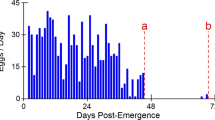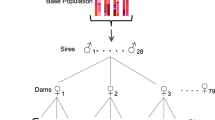Abstract
An approximation method for calculating the effective generation interval in populations with overlapping generations was presented and illustrated with Drosophila melanogaster data where a sustained heterosis (or pseudo-overdominance) was observed for sex-linked genes balanced by an inversion. An equilibrium frequeney was established in replicated 2-bottle population eages which was different for males and females. The fitnesses of the genotypes were thus estimable and the expected gene frequencies with diserete generations were calculated. The effective generation interval was estimated by fitting the observed frequencies to those expected by minimizing the lack of fit chisquare. The best fit resulted if the interval was allowed to increase as the population approached a stable age distribution. The best estimate indicated that there was an average interval of 14.75 days per generation in the first 5 generations and 16.25 days thereafter. This estimate is particular to 2-bottle eages; as the number of bottles increases the expected generation interval is also expected to inerease.
Similar content being viewed by others
References
Anderson, R. L. & L. A. Nelson, 1975. A family of models involving intersecting straight lines and concomitant experimental designs useful in evaluating response to fertilizer nutrients. Biometrics 31: 303–318.
Barker, J. S. F., 1967. The estimation of relative fitness of Drosophila populations. V. Generation interval and heterogeneity in competition. Evolution 21: 299–309.
Barker, J. S. F. & R. N. Podger, 1970. Interspecific competition between Drosophila melanogaster and Drosophila simulans: Effects of larval density of viability, developmental period and adult body weight. Ecology 51: 170–189.
Crow, J. F. & Y. J. Chung, 1967. Measurement of effective generation length in Drosophila population cages. Genetics 57: 951–955.
Chung, Y. J., 1967. Persistence of a mutant gene in Drosophila populations of different genetic backgrounds. Genetics 57: 957–967.
Dobzhansky, T. H., 1947. Adaptive changes induced by natural selection in wild populations of Drosophila, Evolution 1: 1–16.
Frydenberg, O., 1962. Estimation of some genetical and vital statistics parameters of Bennet populations of Drosophila melanogaster. Heredltas 48: 83–104.
Lee, W. H. & T. K. Watanabe, 1977. Accumulation of deleterious genes in a eage population of Drosophila melanogaster. Genetics 86: 657–664.
Miller, R. S., 1964. Larval competition in Drosophila melanogaster and D. simulans. Ecology 45: 132–148.
Reed, S. C. & E. W. Reed, 1948. Natural selection in laboratory populations of Drosophila. Evolution 2: 176–186.
Sved, J. A., 1971. An estimate of heterosis in Drosophila melanogaster. Genet. Res. 18: 97–105.
Wright, S., 1969. Evolution and the genetics of populations, Vol. 2.: The theory of gene frequencies. The University of Chicago Press, Chicago.
Wright, S. & Dobzhansky, T., 1946. Genetics of natural populations. XII. Experimental reproduction of some of the changes caused by natural selection in certain populations of Drosophila pseudoobscura. Genetics 31: 125–156.
Author information
Authors and Affiliations
Additional information
Journal Paper Number 79-5-211 of the University of Kentucky Agricultural Experiment Station, and Journal Paper Number 7942 of the Purdue University Agricultural Experiment Station.
Rights and permissions
About this article
Cite this article
Muir, W.M., Bell, A.E. Estimation of effective generation interval in Drosophila population cages. Genetica 55, 33–37 (1981). https://doi.org/10.1007/BF00134001
Received:
Accepted:
Issue Date:
DOI: https://doi.org/10.1007/BF00134001




